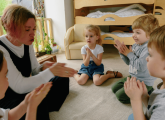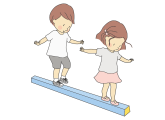Learning about doubles and using them in context is an important early skill to help with mathematical understanding, says Madeleine Fox…
Here are some fun starting points for introducing doubles across the curriculum. These activities can take place indoors or outdoors, and there are also many links for learning about symmetry, shape and pattern.
Start by asking the question, “What are doubles?” Doubles mean “two lots of something”.
Use a box of dominoes and show how we can count the number of spots on each side. Giant classroom dominoes are great for this exercise.
Can children see any dominoes that have the same number on each side? These are doubles. Look at the shape of the spots – they are arranged in the same way as the spots on a die – an easy way to recognise the number without counting.
Share out the dominoes face down, so that each child has at least one. The children turn them over and each child with a double domino scores a point.
Can they add them together and say the number sentence? This can be played as small group or paired activity.
Arrange the double dominoes in order – 1 + 1 , 2+2, 3 + 3 . Invite children to draw a picture of the dominoes and say a number sentence for each one.
Cut black paper into large rectangle domino shapes – fold in half then open back out and paint a white line along the crease.
Paint white spots on one side then fold and open out again to reveal a double domino! Make a display of your domino shapes in increasing order.
You could also cut paper into different shapes – circles, triangles, squares – to print doubles. Children can paint on one side and fold the paper in half to explore which shapes are symmetrical and which are asymmetrical.
Painting butterflies is a lovely summer activity to help children explore symmetry and doubles further.
Fold some paper in half before drawing and cutting half a butterfly shape that can then be opened out into a symmetrical butterfly.
Paint spots, patterns or just drip blobs of different coloured paint on one half of the butterfly shape – fold it to print doubles and patterns, then open out again to reveal beautiful symmetrical butterflies.
Play “Copy me” using musical instruments and different sounds. Bang a drum twice – children copy. Ring a bell three times – children copy. Shake a shaker four times – children copy.
Remember to count each time, then work out how many sounds there are altogether (keep the numbers small).
Start this as an adult-led activity until the children are clear about how to play before inviting different children to lead.
You could take this a step further using rhythm and sound for repeating pattern work. Music is built on repeated rhythm and patterns, and usually has a steady two-, three- or four-beat pulse.
Introduce the pattern first, then count: Clap clap, tap tap, clap clap , tap tap - 1 2 1 2 1 2 1 2.
You can also play “Copy me” through movement. Count as you jump twice, then count as the children copy. Repeat with other movements, such as hopping, star jumps and turns (remembering to keep the number small).
Each team has two hoops, bean bags and a large die. Taking turns, a child from each team throws the die to generate a number. The child then throws that number of bean bags into each hoop and says the number sentence. Or children themselves could jump in the hoops, making human doubles.
You could also use chalk to draw around the bean bags and hoops in the playground. Vary the game by using other objects such as cones and teddies.
Children can now explore how this new knowledge can help them with their everyday mathematical calculations.
Madeleine Fox is an educational writer and former SEN teacher.

Rhythmic play – Why every setting should do it
Editors picks

Early Years development – How to support children
Editors picks
